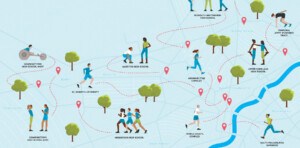Ask Dr. Monti: Is There a Non-Surgical Way to Treat Bunions?
Question: Is there a non-surgical way to treat bunions?
Answer: Bunions are a common problem affecting approximately 30 percent of the U.S. population. A bunion occurs when the tissue or bone located around the base of the big toe becomes enlarged. When this happens, the big toe typically turns inward toward the other toes, and the tissue surrounding the joint becomes swollen and tender. The term “bunion” is used to refer to the pathological bump that forms on the side of the great toe. The placement of the joints, ligaments and tendons in your feet (i.e. your genetic makeup) plays a role in determining your susceptibility to bunions. However, wearing ill-fitting footwear can also contribute to the problem, particularly those stylish shoes that cramp the front of the foot into an overly narrow space. If untreated, bunions can restrict daily activities, cause discomfort, and adversely affect the look and feel of the foot.
Once bunions have developed, there are surgical treatment options, but I generally recommend trying the non-surgical options first. If you have a bunion problem, get a consultation from either a podiatrist or a medical doctor who specializes in orthopedic surgery of the foot.
Corrective Insoles / Orthotics: This is the most common non-surgical defense against bunions. Insoles and orthotics are inserted into your shoes to provide additional padding and support for your feet. Not only do correctly fitted insoles minimize pain, but they can also help reposition your toes. It is best to get these supportive aids from a foot specialist.
Stretching exercises: People with bunions often suffer from stiffness in the affected toes. Stretching your toes and feet can help alleviate stiffness and minimize pain. Such exercises may help minimize the risk of arthritis over time. Your foot specialist can help you with specific stretches.
The Right Shoes: This is important for everyone, not just those with bunions. By the “right shoes,” I mean shoes with adequate padding and those that properly fit your feet (length, width, and appropriate arch support). If you already have bunions, the right-sized shoes will minimize discomfort, and may even help keep your bunions from worsening.
Posture and Gait Therapy: A foot problem often comes as a compensation for a long-term misalignment of the hip, back or even the neck. If that is the case, focused, gentle manipulation that helps to align the body to walk more correctly may help. For this approach, I consulted physical medicine and pain specialist at the Myrna Brind Center, Bettina Herbert, M.D., who relayed that many of her patients with various types of foot pain are helped significantly with a program of postural therapy.
Anti-Inflammatory Aids: There are several anti-inflammatory aids that help manage the symptoms of bunions. Icing your feet for 10 to 20 minutes a couple of times a day will help reduce swelling. It is especially useful to ice after spending a lot of time on your feet. Some doctors may also recommend a low dose of aspirin or ibuprofen, or natural supplements thought to lower inflammation.
E-mail Dr. Monti your question here, and he could answer it an upcoming blog post! Dr. Monti is Director of the Myrna Brind Center of Integrative Medicine at Thomas Jefferson University Hospital and the author of “The Great Life Makeover”. Read more about him here.
Join Dr. Monti’s Facebook Fan Page – Daniel A. Monti, MD – and follow him on Twitter @DanielMontiMD.



